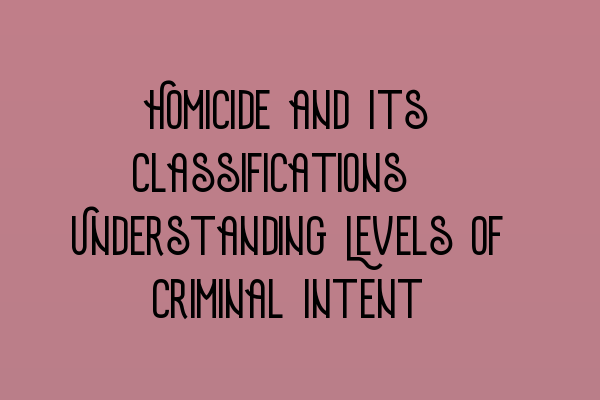Homicide and Its Classifications: Understanding Levels of Criminal Intent
In the field of criminal law, homicide is one of the most serious offenses that one can commit. It refers to the act of causing the death of another person, either directly or indirectly. However, not all homicides are considered equally severe, as the classification of homicide depends on the level of criminal intent involved. Understanding these classifications is essential in comprehending the legal implications and potential outcomes of a homicide case.
1. Murder
Murder is the most serious type of homicide and involves the intentional killing of another person with malice aforethought. Malice aforethought refers to the presence of either an intent to cause serious bodily harm or the knowledge that the act is likely to result in death. Murder can be further classified into first-degree murder and second-degree murder.
1.1 First-Degree Murder
First-degree murder involves premeditation, planning, and a deliberate intent to cause the death of another person. This means that the offender had the opportunity to reflect on their actions before committing the act. First-degree murder is usually associated with highly vicious and calculated crimes.
1.2 Second-Degree Murder
Second-degree murder, on the other hand, lacks the element of premeditation. It is still an intentional killing, but without the planning and premeditated intent. Crimes categorized as second-degree murder often stem from spontaneous or impulsive actions where the perpetrator did not have a specific plan to cause the death of the victim.
2. Manslaughter
Manslaughter involves unlawfully causing the death of another person without malice aforethought. Unlike murder, manslaughter is generally associated with a lack of intent to cause harm or death. Manslaughter can be further divided into voluntary manslaughter and involuntary manslaughter.
2.1 Voluntary Manslaughter
Voluntary manslaughter occurs when the offender intentionally causes the death of another person, but under certain mitigating circumstances. These circumstances usually involve a sudden and intense provocation that would cause a reasonable person to lose control and act on impulse. The provocation must be sufficient to cause an individual to temporarily lose the ability to think rationally.
2.2 Involuntary Manslaughter
Involuntary manslaughter, on the other hand, occurs when the offender unintentionally causes the death of another person through recklessness or criminal negligence. This means that the offender did not have the intention to cause harm or death, but their actions or negligence resulted in a fatal outcome.
Understanding the different classifications of homicide is crucial in criminal law as it helps determine the appropriate charges and potential penalties for offenders. By analyzing the level of criminal intent involved in a homicide case, legal professionals can build strong arguments and present a compelling case in court.
If you are interested in learning more about criminal law and preparing for the SQE exams, we offer a wide range of preparation courses to help you succeed. Check out our related articles for more information:
SQE 1 Practice Exam Questions,
SQE 1 Practice Mocks FLK1 FLK2,
SQE 2 Preparation Courses,
SQE 1 Preparation Courses,
SRA SQE Exam Dates
